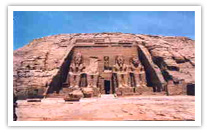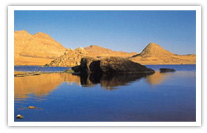 |
1-
Abu Simbel :
is a set of two temples near the border of Egypt with
Sudan. It was constructed for the pharaoh Ramesses II
who reigned for 67 years during the 13th century BC (19th
Dynasty).
The temples were cut from the rock and shifted to higher
ground in the 1960s as the waters of Lake Nasser began
to rise following completion of the Aswan High Dam.
The Great Temple is dedicated to Ramesses II and a statue
of him is seated with three other gods within the innermost
part of the rock-cut temple (the sanctuary). The temple's
facade is dominated by four enormous seated statues of
the Pharaoh (each over 20 metres or 67 feet high), although
one has been damaged since ancient times.
The Small Temple was probably completed ahead of the Great
Temple and is dedicated to Ramesses' favourite wife, Nefertari.
At the entrance stand six 10-metre-high (33 feet) rock-cut
statues - two of Ramesses and one of Nefertari on either
side of the doorway.
The temples can be reached by road, air or boat. Arrival
by boat is achieved by cruising from the Aswan High Dam
on a 3-day journey. The author first made the trip on
the "Eugenie" in January 1995 with the vessel
stopping at various relocated temples along the way. In
early 1998, the journey was repeated on the "Nubian
Sea", but the number of tourists reaching Abu Simbel
in this way remains relatively small.
|
 |
2
- Lake Nasser
Llarge reservoir, 480 km (300 mi) long, on the Nile River,
behind Aswan High Dam, in southern Egypt and northern
Sudan.
Named for Gamal Abdel Nasser, president of Egypt from
1956 to 1970, the reservoir is used for hydroelectricity
production, fishing, and irrigation. About 14 percent
of the water contained in Lake Nasser evaporates, reducing
the amount of Nile water downstream.
Before Lake Nasser was formed, the area was the site of
the temples of Abu Simbel, which were built by Egyptian
pharaoh Ramses II in the 1200s BC. During the construction
of the Aswan High Dam in the 1960s these temples were
moved, but many other historic monuments were submerged.
Also submerged is a portion of the historic lands of the
Nubians, who lived along the Nile between Aswan and Khartoum,
Sudan, for thousands of years.
|
 |
| |
|
| |
|
|
|


